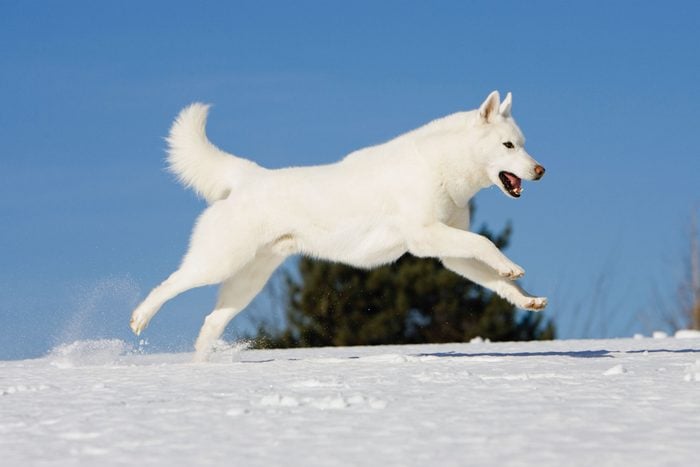
We’re paws-itive you’ll love these cute white dog breeds
It’s true: All dogs are adorable. But there’s something extra magical about white dog breeds. With their dazzling bright coats, they look like they just stepped off a cloud—or the set of Frozen. Which is probably why so many all-white dogs top the list of America’s most popular breeds.
But there’s more to white dogs than just good looks. Many actually got their pure-white coats because they had jobs to do. “If you were looking for a dog to guard a flock of white sheep, you’d want a white dog,” says Dayna Dreger, PhD, a senior staff scientist with the Dog Genome Project at the National Human Genome Research Institute. “The idea is that they would blend in with the flock so they could keep a sneaky eye out for predators.”
Some breeds developed all-white coats as a kind of camouflage in snowy climates, while others were bred to be white so hunters could easily tell their hunting dogs from their prey. And sometimes people just liked the way dogs looked in white. “Not everything is functional,” says Elaine Ostrander, PhD, founder of the Dog Genome Project. “Sometimes it’s just about looking pretty.”
We talked to a panel of canine experts about some of the most popular white dog breeds and how best to take care of your own snow-white companion.
Get Reader’s Digest’s Read Up newsletter for more pets, humor, travel, tech and fun facts all week long.
About the experts
Reviewed for accuracy by: Caroline Coile, PhD, an award-winning journalist specializing in canine breeds, health and science. She’s the author of 34 books, including Barron’s Encyclopedia of Dog Breeds. |
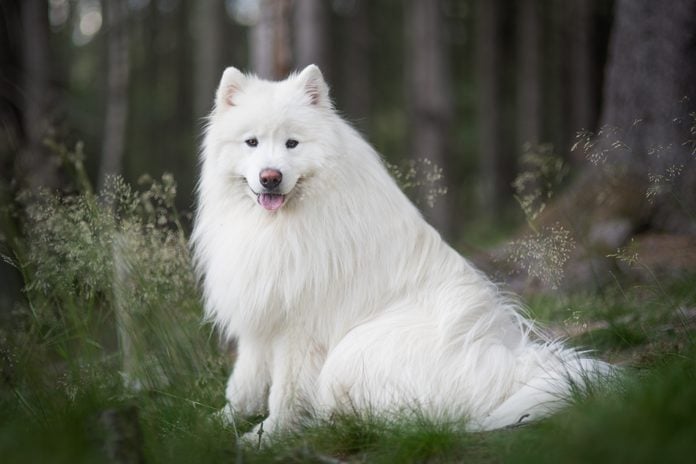
Samoyed
The Samoyed is one of the most beautiful white dog breeds out there—just look at its pure-white, fluffy coat! The thick fur was meant to protect these dogs from harsh winter conditions, as they were bred to work in cold climates. If it looks like your Sammie is always smiling, well, there’s a good reason for that: Their mouths turn upward at the corners to prevent icicles from forming around their lips when they’re working in arctic conditions.
In addition to being absolutely adorable, this Russian dog breed is known for being friendly, smart and highly energetic. “If you have a Samoyed, expect to invest quite some time to teach [it] the basics, such as not pulling on a leash or coming when called,” says professional dog trainer Steffi Trott.

Bichon frisé
Look at that all that fluff! The bichon frisé is one of those small white dog breeds that make you smile as soon as you see one. “They were bred for being cute,” says Ostrander. “I love their little lion mane and the way they think they’re a big dog when they’re just walking around.” Bichons are sturdy, adaptable and curious, and they generally get along well with adults, children and other dogs. They’re also pretty easy to train—these canines love learning new tricks and showing them off to anyone who will watch. They’re the ultimate triple threat: fluffy, fair and fun!
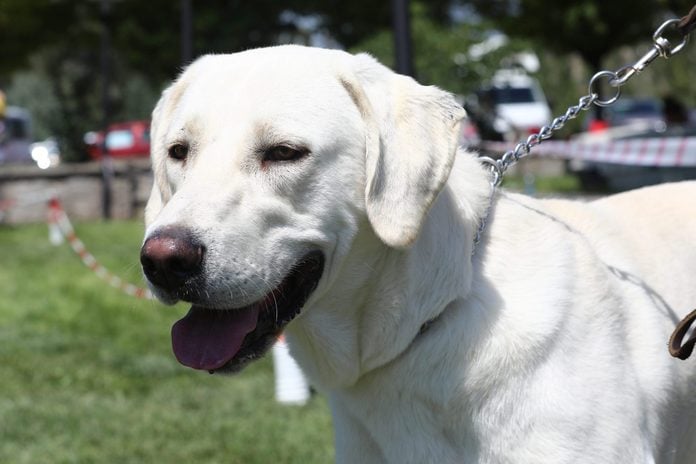
Akbash dog
The Akbash is one of the rarer large breeds of white dog. It was introduced relatively recently to the United States—in 1970—and isn’t yet recognized by the American Kennel Club. This breed comes from Turkey, where the dogs were originally bred to guard livestock. As such, it’s in their nature to herd, protect and be independent. They’re also smart, loving and loyal dogs. And, of course, they’re totally adorable!
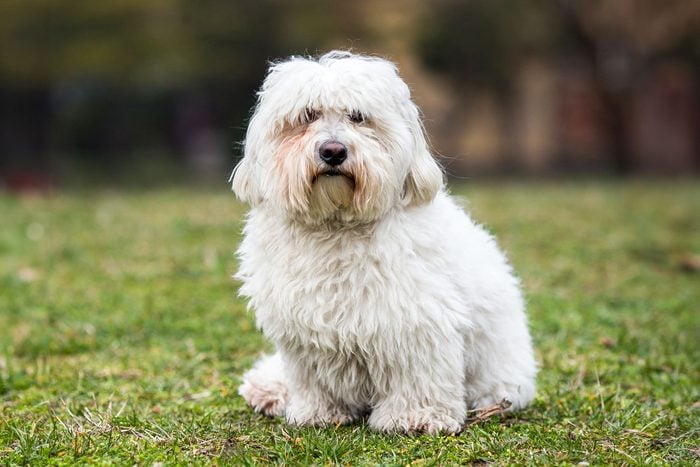
Coton de Tulear
Known as the royal dog of Madagascar, the coton de Tulear is a white dog breed with an interesting history. The nobles of Madagascar loved having these charming pups as pets—so much so that they banned common people on the island from owning them. The nobles also didn’t want their precious pets to leave the island, so they were isolated from the world for centuries. It wasn’t until the 1960s that they were introduced to dog lovers outside of Madagascar.
Known for their gorgeous white coats and fun personalities, these dogs are witty and love to amuse their companions. (You may even see one of these cuties walk on its hind legs!) “They are very friendly and rarely exhibit problematic behaviors, such as reactivity or high prey drive,” says Trott. “This makes them perfect beginner dogs.”
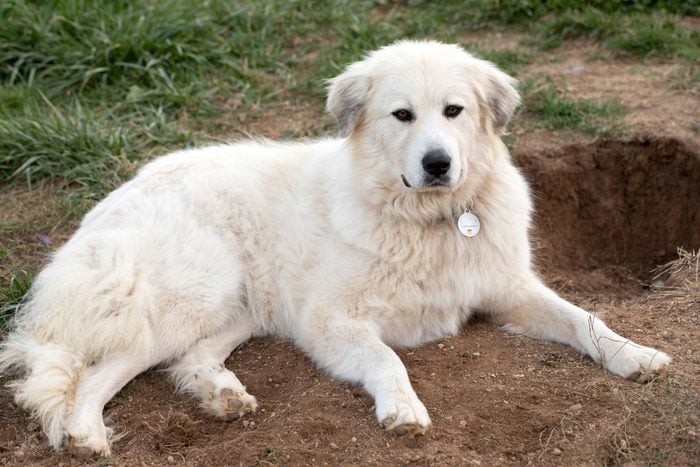
Great Pyrenees
The Great Pyrenees is one of the most adorable and calmest dog breeds with all-white fur. But don’t let their mellow demeanor fool you—they’re known to be powerful guardians of their companions, so they can jump into action if needed. “The Great Pyrenees will look like they’re just lying in the middle of a field with the flock, but they’re always working, listening for sounds, catching odors and observing their surroundings,” says Dreger. “They can hear the rustle of grass a hundred yards away.” These large pups have a signature thick white coat that makes them look majestic and fluffy. You’ll want to run your fingers through it for hours!
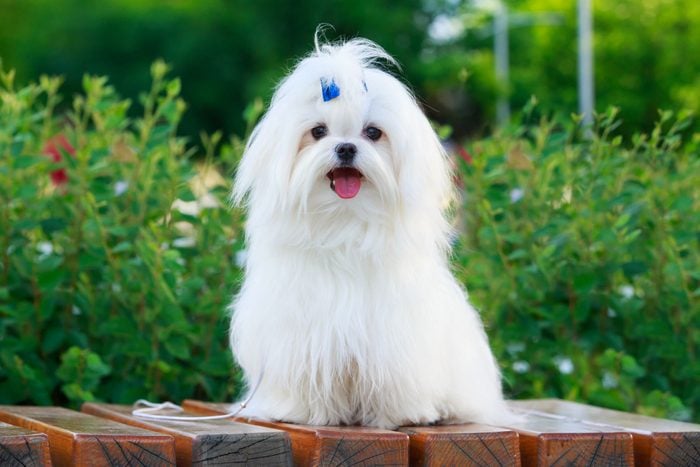
Maltese
The little Maltese is one of the most recognizable white dog breeds—just look at its incredible coat! These toy dogs make the perfect lap companions and are known for being charming and playful. “They’re a little clownish,” says Dreger with a laugh. “They were bred to entertain the ladies while the men were out doing ‘manly’ things.”
Make no mistake: Though fun-loving, they can alert their owners if something bad is afoot. If you want a Maltese, make sure you have a daily grooming routine set up so its gorgeous coat stays in good shape.
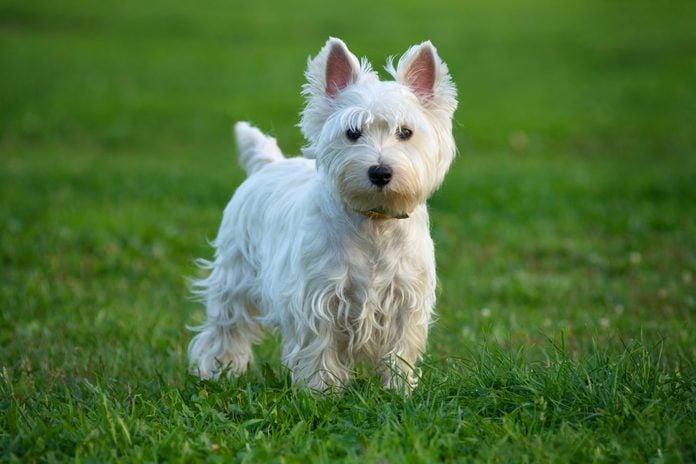
West Highland white terrier
Fair warning: A West Highland white terrier (also know as a Westie) may steal your heart. This is one of the most adorable white dog breeds you can encounter, with a plush look that’s inviting, friendly and super snuggly. But there’s more to this small breed than meets the eye.
Westies were bred to be hunters and to chase small prey out of holes and dense brush. In fact, that’s how they got their coloring. “If they’re dashing out of a hole after a fox, you needed to know which one to shoot at,” says Dreger. “So don’t shoot the white one; shoot the other one! They were bred to be white for that quick determination.” These dogs are smart, confident and tough. And they make loyal (and adorable) companions.
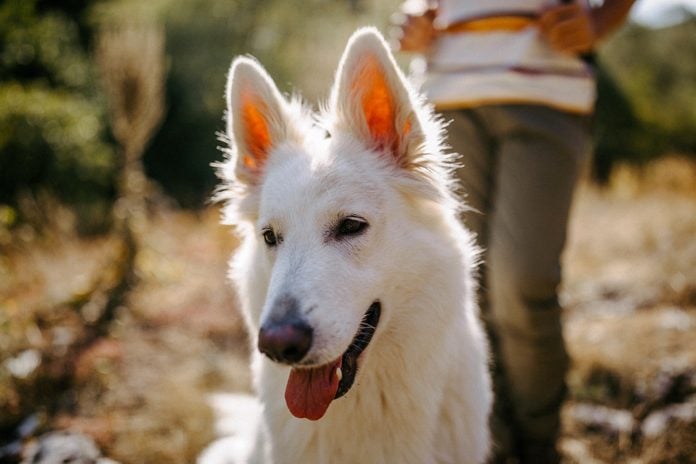
White Swiss shepherd
The pointed ears( check out our list of dogs with big ears and dogs with floppy ears ), the white coat, the sweet smile—these are just a few things that make the white Swiss shepherd a great pet. The breed is closely related to the German shepherd and is a herding breed by nature, which means these dogs are attentive and agile. They’re also great with kids and are very loyal to their owners.
Trott says this breed has an intense desire to work and learn, which comes in handy with training. “Training a white Swiss shepherd will come easily,” she explains. “They excel not only in beginning obedience training but also in dog sports such as agility or competition obedience.” Smart, loyal and cute—what’s not to love? The only downside: You may have a hard time finding one; the white Swiss shepherd isn’t an American Kennel Club–recognized breed and is very rare in North America. It is, however, recognized by the Fédération Cynologique Internationale, the largest kennel club in the world.
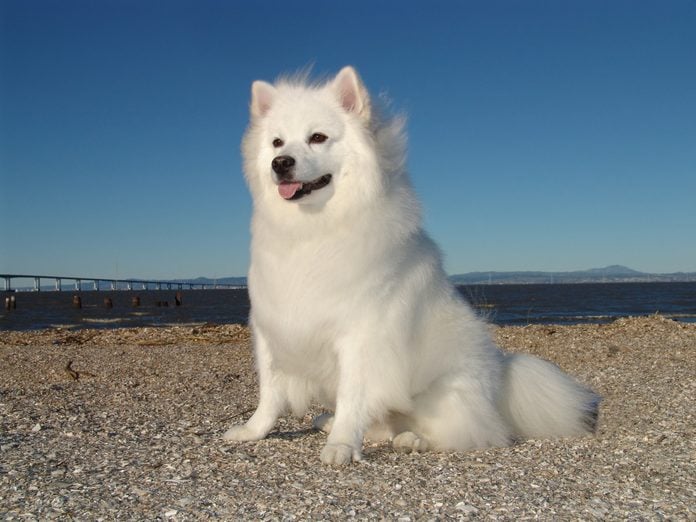
American Eskimo dog
We dare you not to smile when looking at an American Eskimo dog. While these pups are absolutely beautiful, they’re also very smart. They’re such intelligent dogs, in fact, that traveling circuses used to use them in trained-dog acts. American Eskimo dogs are alert, friendly and some of the easiest dogs to train. But heads up, prospective owners: These dogs shed their beautiful fur quite a bit, so prepare to do a deep brushing a couple times per week to keep the coat in good condition.
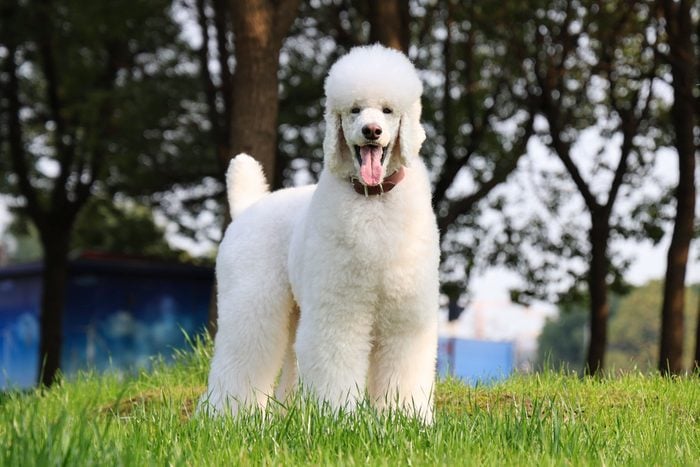
Poodle
Poodles come in three sizes (miniature, toy and standard) and a wide array of colors—”everything from creams and whites to reds, browns, blue and black,” says Ostrander—but there is something particularly striking about a white poodle. With their poofy coats and regal bearing, these pups are as captivating as they are lovable. They’re also active, proud and incredibly intelligent. Smart and adorable? A winning combination!
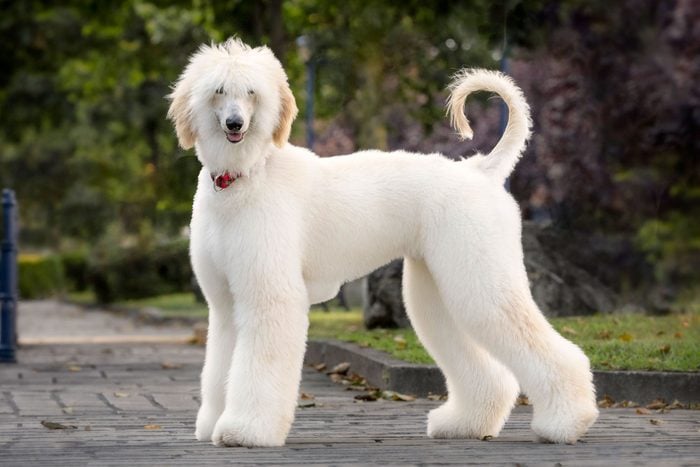
Afghan hound
The Afghan hound is among the most distinguished dog breeds. (Just look at that supermodel pose!) Many people associate their long, silky coats with a regal and dignified look. But there’s more to this long-haired stunner than meets the eye. Afghan hounds are independent, intelligent and fiercely loyal. Their coats can be multiple colors (black and tan are most common), and if you see a white Afghan hound, you’re in luck. Its striking beauty will make quite the impression.
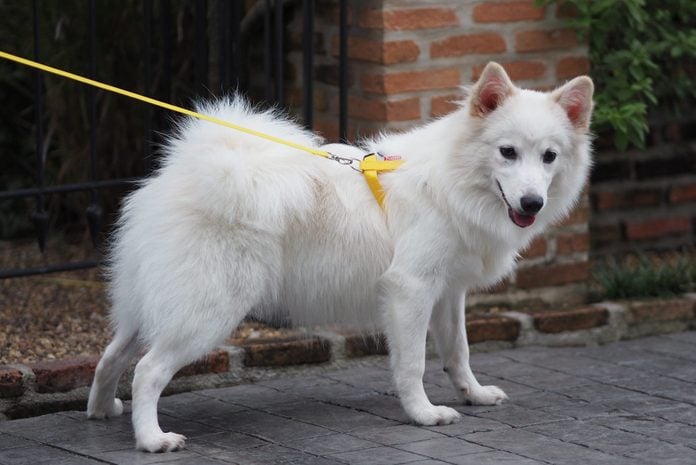
Japanese spitz
While it looks nearly identical to the American Eskimo dog, the Japanese spitz is a distinct breed. And it’s one you’ll have a hard time finding in North America because it’s not recognized by the American Kennel Club (though it is recognized by the Fédération Cynologique Internationale).
These dogs are known for their fox-like features and fluffy white fur. (Just look at that face—how sweet!) They’re also known for their wonderful personalities. “Japanese spitz dogs are very happy and outgoing,” Trott says. “They are highly intelligent and learn quickly with positive reinforcement techniques.” Bonus: These pups typically get along well with kids and other dogs.
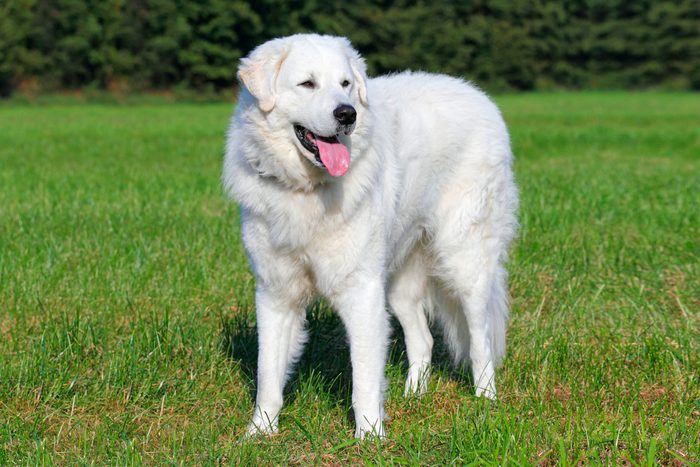
Kuvasz
The kuvasz is another example of those big white dog breeds that are cute, loyal and agile. The kuvasz was initially bred to guard livestock, and because of that, these dogs have keen instincts to protect the ones they love. “The kuvasz is a very stately dog, and it stands around very calmly with the sheep, but then when the fox or wolf comes around, it’s a different story,” says Ostrander. “It will take on the threat to protect the flock.”
Despite their protective instincts, these pups are gentle with their humans. Kuvaszok (that’s the term for more than one kuvasz, though we’d argue it’s also the word for “good dogs”) are quick learners and highly intelligent.
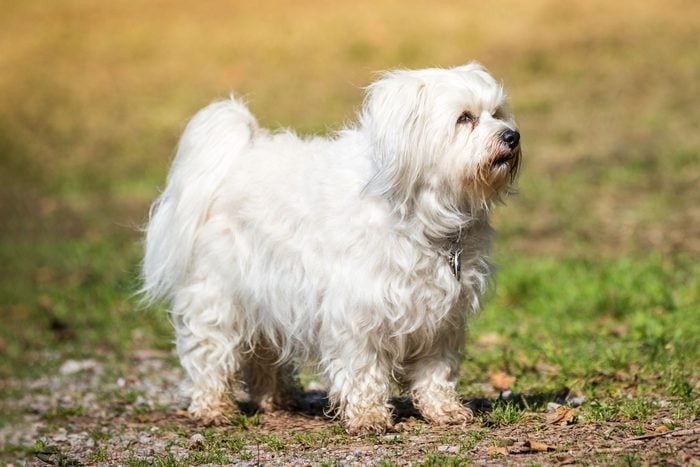
Havanese
Like their cousins the bichon frisé, the Maltese and the coton de Tulear, the Havanese are known for their excellent social skills. “All those breeds are traced back to the same line and what’s generally called ‘the dog from Malta,'” says Dreger. “It was apparently a little white fluffy dog that was quite common on merchant ships that visited all these different locations.”
Havanese are smart little pups and can be easily trained, which is why they’re one of the best trick dogs out there. Teach them a trick or two and watch them delight the room!
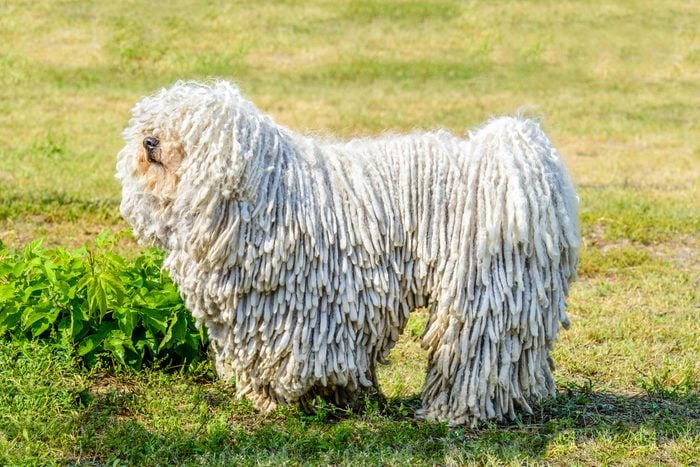
Komondor
The komondor is one of the most recognizable white dog breeds out there—this pup looks like an oversized mop! It’s covered in white cords from head to foot, but you can still see its sweet smile lighting up its face. While komondorok (the plural form of komondor) are primarily known for their unique look, they’re also agile and protective in nature. Just know that komondorok didn’t look that good while they were working the fields guarding their sheep. “Their thick coat may have started out as protection against the brush and the rain, but you’d never see a komondor working out in the field with a fully corded coat,” says Dreger. “They’ve been fancied up a lot over the years.”
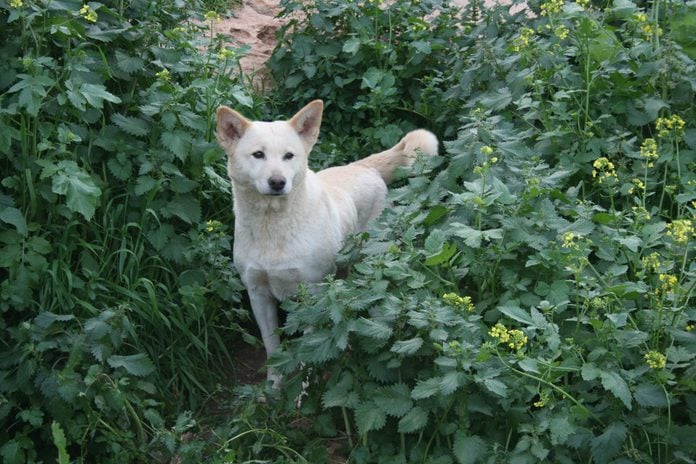
Canaan dog
These cute, confident canines are one of the oldest dog breeds in the world. They come in a variety of colors, but the all-white pups are some of the most striking you’ll see. Canaan dogs are loyal to their loved ones but are suspicious of strangers due to their roots as pasture dogs. They’re clever guardians of flocks … and homes. Once they know you, though, get ready—you’ll have a furry friend for life!
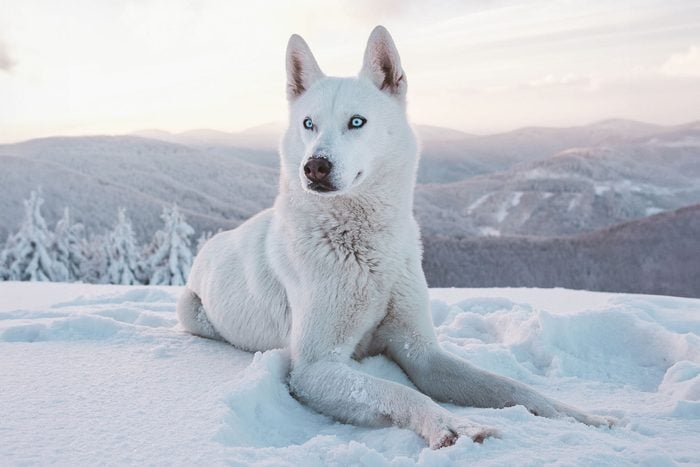
Siberian husky
This gorgeous breed has a thick coat of fur that’s a nod to its northern ancestors, and it comes in a range of colors. Most of these dogs have different colors mixed into their fur, but if you see a snow-white husky, you’ll be blown away by its beauty.
The prototypical sled dog, the Siberian husky knows how to get a job done. These friendly, energetic dogs are also pack animals, so they enjoy the company of others and are loyal to their family. But watch out if your family includes pets of a smaller size. While huskies are gentle and lovable, they do have a weakness for chasing small creatures, so keep your husky away from your cat.
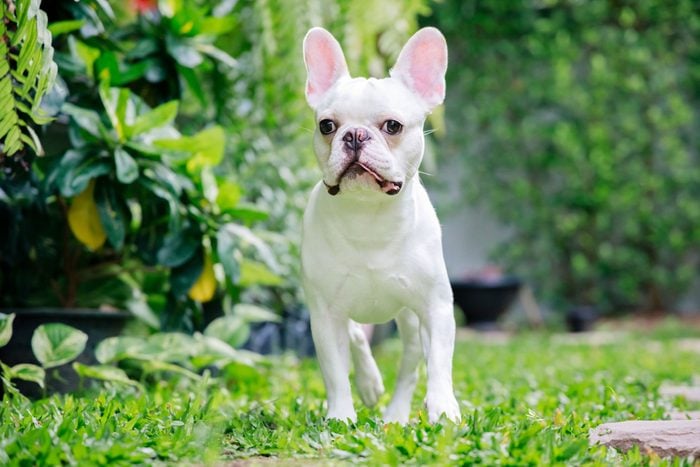
French bulldog
The wrinkles, the pointed ears, the contagious smile—what’s not to love about the French bulldog? Frenchies are adorable, adaptable dogs known for being charming, smart and lots of fun to be around. And in the American Kennel Club’s latest ranking, they unseated the reigning champs, Labrador retrievers, as the most popular dog breed in the country. Don’t be surprised if a Frenchie steals your heart!
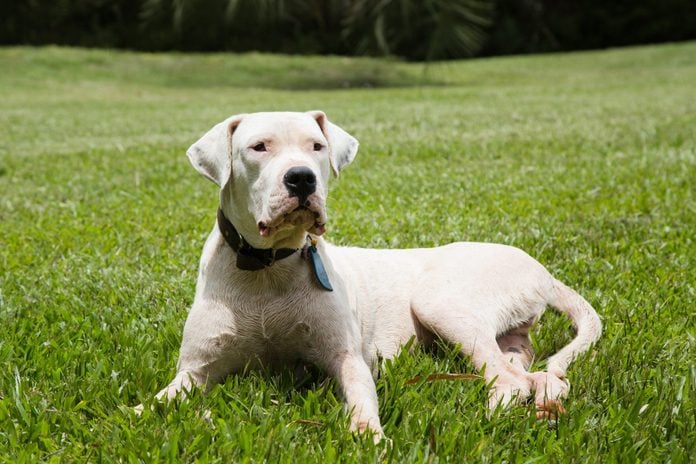
Dogo Argentino
One of the most powerful big, white dogs is the dogo Argentino, a breed that’s known for being loyal and brave. (You’d be brave too if you were bred to hunt big game like wild boar!) Built to chase and catch dangerous game, the athletic dogo Argentino will sniff everything in sight. Don’t be surprised to see this cute dog spending time with loved ones when it’s not working. They may look intimidating at first, but once you see their smile, you’ll melt.
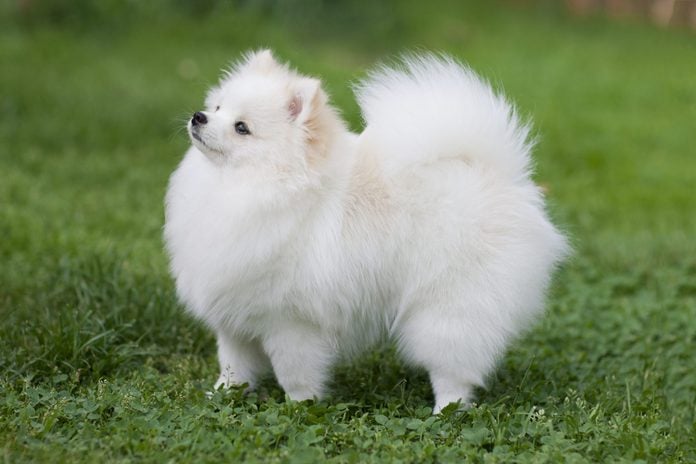
Pomeranian
You know we had to save one of the most adorable white dog breeds for last! This curly-tailed cutie is a small dog with a big, bold personality—these pups have no problem letting people know they’re in their presence. You’ll admire the spunk these lively pups have, and you’ll be impressed by how they captivate a room. These little characters are cute, charming, curious and very smart.
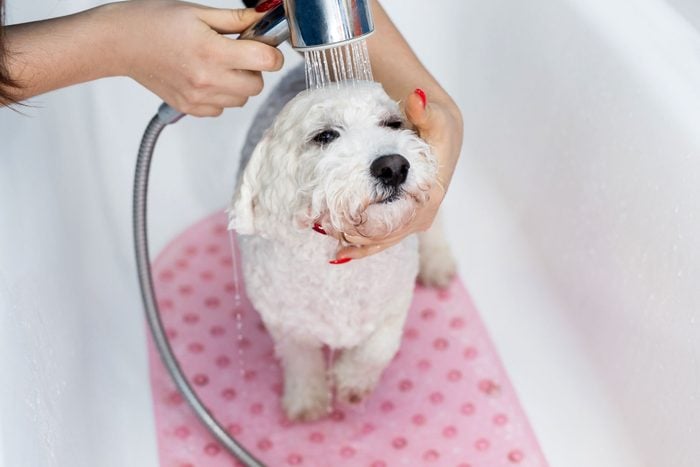
FAQs
Do white dogs need special care?
It depends. “With all dogs, I just recommend bathing them when they’re dirty but definitely no more than once or twice a month,” says Vered Bar, VMD, a veterinarian at San Francisco Animal Medical Center. “You don’t want to overdo it because you strip them of the natural oils that they have in their skin.”
That goes for bathing your pet at home and taking it to the groomer. Obviously, if your dog gets into something filthy, it’ll need to be cleaned, but regular brushing and the occasional swipe with a grooming wipe can keep pets clean in between baths.
Why do white dogs’ eyes get tear-stained?
Blame it on a group of compounds known as porphyrins, which are molecules produced when the body breaks down red blood cells. Dogs excrete porphyrins through their tears, and when an iron-containing porphyrin sits on white fur, it stains it brown or red. Porphyrins are also found in dogs’ saliva and urine, leading to rusty stains around the mouth, undercarriage and wherever they tend to lick themselves. It’s the reason owners of white dogs sometimes wonder if their pet’s fur is turning brown.
“It’s not harmful,” says Amy Tate, DVM, a veterinarian in Birmingham, Alabama. “It’s just really a cosmetic issue.”
How do you clean dogs’ tear stains?
The best way to avoid tear stains is to keep the area dry and wipe away excess tears or saliva on your dog’s fur before it has time to stain. The goal? “General cleanliness, wiping away any tearing and keeping the hair around the eyes trimmed short to avoid excess tearing,” says Dr. Tate.
While there are some wipes, eye washes and supplements on the market that promise to fade the stains (or prevent them from occurring), you don’t have to invest in these pet-grooming products. Besides, results vary by dog. “The key is really keeping the areas dry,” says Dr. Tate. ‘The stained fur will fade and eventually grow out.”
Are white dog breeds more likely to be deaf?
Some of them are. Congenital deafness associated with lack of pigmentation has been reported in Dalmatians, bull terriers, English setters, English cocker spaniels, Australian cattle dogs, Catahoula leopard dogs, Jack Russell terriers, Havanese, whippets, dogos Argentinos, Boston terriers, Cavalier King Charles spaniels, English bulldogs and French bulldogs. “I would also add boxers and border collies to that list,” says Dreger. “Note that some of the breeds have not been tested in sufficient numbers to suggest significance in the percentages, only the presence of the condition.”
The condition, which is generally referred to as sensorineural deafness, is caused by a lack of pigment cells called melanocytes in the inner ear, where tiny hairs capture sound waves and send them to the brain for processing. How is that connected to coat color? The embryonic cells that turn into the inner ear melanocytes are the same ones that turn into the melanocytes that produce coat color. “If the initial migration of those cells throughout the body of the embryo is disrupted, the results will occur in both the pigment of the animal and the sensory cells in the inner ear,” says Dreger.
Clearly, not all white dog breeds are affected, and that’s because there are a couple of ways in which a dog may appear white in color. Some, like Dalmatians, boxers and bull terriers, “are white because of genetic mutations that prevent the proper migration of pigment cells throughout the body,” Dreger says. “They do not have sufficient numbers of pigment cells to color the hair.” Other breeds, like the Samoyed and white spitzes, are white “because of an extreme dilution of the pigment rather than the absence of the pigment cells altogether. This type of white is not generally associated with deafness.”
Why trust us
At Reader’s Digest, we’re committed to producing high-quality content by writers with expertise and experience in their field in consultation with relevant, qualified experts. For this piece, Cynthia Sanz Carstens tapped her experience as an award-winning journalist specializing in pets, and then Caroline Coile, PhD, an award-winning journalist specializing in canine breeds, health and science, gave it a rigorous review to ensure that all information is accurate and offers the best possible advice to readers. For this piece, we relied on reputable primary sources, including veterinarians, canine geneticists, professional organizations and academic institutions. We verified all facts and data and backed them with credible sourcing, and we will revisit them over time to ensure they remain accurate and up to date. Read more about our team, our contributors and our editorial policies.
Sources:
- Elaine A. Ostrander, PhD, founder of the Dog Genome Project at the National Human Genome Research Institute, a division of the National Institutes of Health; phone interview, Jan. 29, 2024
- Dayna Dreger, PhD, senior staff scientist at the Dog Genome Project; phone interview, Jan. 29, 2024
- Vered Bar, VMD, chief-of-service veterinarian for primary and urgent care at San Francisco Animal Medical Center; phone interview, Feb. 5, 2024
- Amy Tate, DVM , co-owner of the Riverview Animal Clinic in Birmingham, Alabama; phone interview, Feb. 5, 2024
- Steffi Trott, professional dog trainer and the owner of Spirit Dog Training in Cedar Crest, New Mexico; interviewed March 2021
- Brandi Munden, vice president of communications for the American Kennel Club; email interview, Jan. 31, 2024
- United Kennel Club: “The Akbash Dog”
- White Swiss Shepherd Club of America
- LSU School of Veterinary Medicine: “Breed-Specific Deafness Prevalence In Dogs (percent)”
